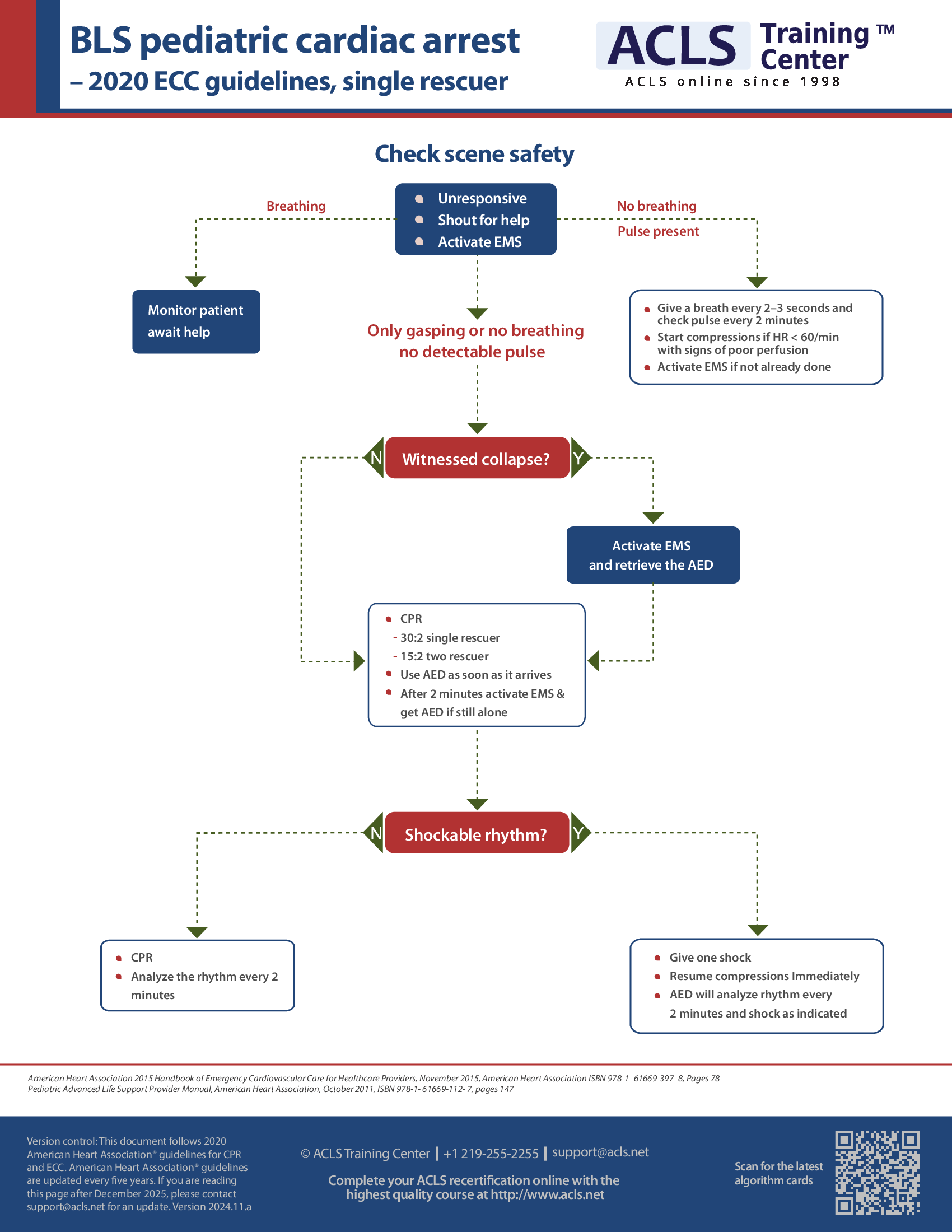Pediatric cardiac arrest algorithm—basic
 Written by
Jessica Munoz DPN, RN, CEN
Written by
Jessica Munoz DPN, RN, CEN
Changes: Updated compression rate to 100-120/min per 2025 AHA guidelines
When responding to help a child, make sure to check for scene safety first. Check for responsiveness, shout for help, and activate EMS. If the child is breathing, stay with them and wait for help. If the child is not breathing and they have a pulse, provide a breath every 2–3 seconds and continue checking for a pulse every 2 minutes. Start chest compressions if the heart rate is < 60/min with signs of poor perfusion. Activate EMS if not already done.
If you witness the child is only gasping or not breathing and does not have a pulse, activate EMS and get an AED. If the child is found unresponsive, start CPR. A single rescuer should perform compressions at a rate of 30 to 2 breaths. Two rescuers should perform CPR at a ratio of 15 compressions to 2 breaths. Use the AED as soon as it arrives. After 2 minutes of CPR, activate EMS if not done already and get the AED. If a shockable rhythm is not detected start CPR and analyze the rhythm every 2 minutes. If a shockable rhythm is detected, give one shock and resume compressions immediately after the shock. Analyze the rhythm every 2 minutes and continue CPR until advanced life support arrives or the child becomes responsive.
Summary of steps of cardiopulmonary resuscitation
This algorithm outlines the differences between the CPR steps in adults, children, and infants.
- Recognition of unresponsiveness for adults involves absence of normal breathing, any breathing, or gasping. Recognition for children and infants is gasping or no breathing.
- In all the age groups if no pulse is felt within the first 10 seconds, the CPR sequence should be initiated—compressions of the chest, providing airway, and breathing (C-A-B).
- The compression rate should be 100–120/min for both children and adults.
- For adults, the depth of compression should be at least 2 inches (5 cm); for children, it should be 1/3 of anterior-posterior chest diameter or about 2 inches; for infants, it is at least 1/3 of the anterior-posterior chest diameter or about 1 and 1/2 inches (4 cm).
- In all the age groups, the chest should be allowed to recoil completely between compressions.
- The compressors may be rotated in 2 minutes intervals. Interruptions between compressions should be minimized as much as possible and should be restricted to less than 10 seconds.
- Airway may be provided through a head-tilt-chin-lift method while in case of suspected trauma, the jaw-thrust method should be used. Until the placement of advanced airway, the compression to ventilation ratio should be maintained at 30:2 (with 1–2 rescuers in action) for adults; for children and infants, the ratio needs to be at 30:2 (single rescuer in action) while 15:2 (2 rescuers in action).
- For all the age groups, with advanced airway in place, 8–10 breaths/min should be provided, that is 1 breath every 6–8 seconds. The breathing needs to be asynchronous with chest compressions, around 1 second per breath with visible rise in chest.
- As soon as available, the AED leads should be attached and put to use. Before and after shock, interruptions between chest compressions should be minimized. Immediately following each shock, CPR should be resumed with chest compressions.
Printed crash cart cards

Order the full set of printed crash cart cards.

Planning to certify/recertify ACLS?
Get a reminder when you need to take the exam
Please verify or enter a different email address:
How we reviewed this article
Our experts continually monitor the medical science space, and we update our articles when new information becomes available.
-
Current versionMail the author of this pageEmail
- Dec 4, 2025
-
Copy edited by:
Copy editorsChanges: Updated compression rate to 100-120/min per 2025 AHA guidelines - Jul 29, 2021
-
Written by:
